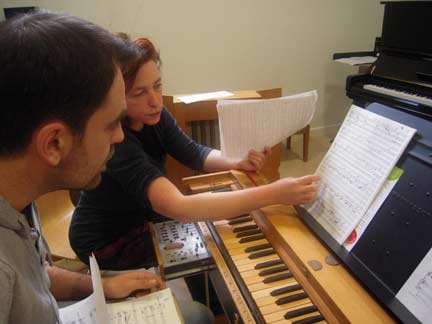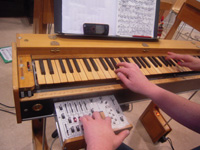World Tracks
Sculpting music with the ondes martenot
by Alison Hird
Article published on the 2010-01-15 Latest update 2010-01-18 18:14 TU

Christine Ott also uses the ondea, similar to the ondes martenot, in her classes
(Photo: Alison Hird)
World Tracks: Christine Ott
Christine Ott is one of only a handful of ondistes in the world. I meet her at the Conservatoire de Strasbourg where she’s giving her weekly ondes martenot (Martenot waves) class, helping accomplished music students get to grips with glissandi, vibrati and rubato on weird and wonderful-looking scores. She’s just spent 10 days touring across Europe with Yann Tiersen in whose band she's been playing ondes martenot for more than five years.
She’s tired but has lost none of her patience and determination to keep the classes going, transmitting her knowledge and enthusiasm for the instrument.
Sitting at the keyboard with a metallic ring on her index finger, she whizzes along a wire (like a fishing line, she says) making theremin-like sweeps in tone.
The sound actually comes not from the keyboard, but a small draw of controls she operates with her left hand. The controls determine the musical dynamics, from silence to fortissimo. The main one is a lozenge-shaped expression touch that Ott compares to a violinist using a bow. The drawer also has flip-switches to get a whole range of timbres and allows you to switch between four different loudspeakers or sound diffusers: the main traditional one, a reverb effect, metallic gong and a lyre-shaped one called a Palme using strings.
“You have so many different sounds... sounds in the sky and then more industrial sounds”. She compares playing the instrument to an artist sculpting. “With ondes martenot I have two pictorial ideas: to have lots of colours and timbres. It’s like sound sculpture for me.”
The instrument was invented in 1928 by Maurice Martenot, a French radio transmissions expert and cello player. During World War I he’d been intrigued by the way tones overlapped on military radio oscillators and set out to develop an instrument that could reproduce that sound.
Great musicians have composed for ondes martenot; most famously Olivier Messiaen, whose "Trois Petites Liturgies" and "Oraison" remain classics. Pierre Boulez also wrote pieces but Ott tells me he forbid anyone to play the music. Modern composers include Thomas Bloch and Tristan Murail. Ott declines to call herself a composer but improvises pieces first on piano which she then transcribes for ondes.
Having worked with many classical and pop musicians, she’s now brought out her own debut album called Solitude Nomade. It’s a series of duets: ondes and vibraphone, ondes and cello, ondes and electric guitar to name but a few. “They’re sort of love duets” she explains, “like a couple and this couple is existing all around this voyage”.
Playing and promoting ondes martenot is not without its challenges. Ott says there are relatively few scores and many are out of print. There’s also a lack of new material because most composers think the instrument has died out or they associate it with science fiction.
The ondes have indeed featured regularly in sci-fi movies such as the soundtracks to Mars Attack and The Invisible Man. Ott says it’s done the instrument a disservice, with some composers refusing to take the instrument seriously. She’s struggled to get them interested in writing pieces for ondes.
“They say 'oh it’s just an old synthesiser.' For me it’s had a bad influence on the instrument.”
But the tide seems to be turning a little. Not least because musicians like Yann Tiersen, Syd Matters and, perhaps most famously, Jonny Greenwood from Radiohead are all fans. Radiohead has used a group of six ondes martenots in live versions of Arpeggi and How to Disappear Completely.
Ott played her ondes with Radiohead in a concert broadcast on Canal+ television in France.
“It was an amazing moment”, she says, describing the strong sensation you get from having six ondes martenot together on stage. She composed the first track on her album Pensées sauvages in memory of that musical collaboration.
Interest in ondes is now growing among music students here in France, which remains the birthplace and continuing cradle for ondes.
“The level of interest has really grown over the last five years” Ott explains. “We have nine students this year, including a couple from Brazil and Switzerland”.
Julie Pierrejean, 28, plays bass in a band but enrolled for ondes martenot classes seven years ago when she heard this haunting sound in the conservatoire corridors.
“It reminded me of a UFO” she says cheekily. She still thinks of the sound as akin to a human voice, “a little person singing strangely but really well”. She’s started composing for choreographies and would love to make music for films or documentaries.
While there’s growing enthusiasm, one problem remains the shortage of instruments. Production stopped in 1988 and Ott tells me they’re increasingly difficult to find. Many are in a piteous state and getting them repaired can take months.
Ambro Oliva is bringing new hope. He’s been making a very similar instrument known as the ondea since 2003. It has an extra octave but is otherwise comparable to the ondes martenot with a lovely sound and wooden keys that Ott really appreciates. For the moment however, only the main speaker is finished while the reverb is in progress.
Ott regularly uses an ondea for both teaching purposes and on stage, but remains deeply attached to her own ondes martenot: a prototype originally loaned to her by Maurice Martenot’s son Jean-Louis.
“It’s like a violin; the timbres become very personal, they change over time.”
Ondes martenot may be electronic but they’re not robots: they have a voice, and a personality.
World Tracks
Moving on up with Angélique Kidjo and Bibi Tanga and the Selenites
2010-02-12 17:31 TU
Nneka: hip-hop till you drop
Nigerian-German hip-hop/soul artist Nneka has come a long way since she first spoke to Worldtracks in 2007. With the release of her fourth album Concrete Jungle and a guest appearance on the David Letterman show in the US, she’s quickly becoming one to watch.
2010-02-06 11:27 TU
Sounds from the River Niger
2010-01-30 16:33 TU
World Tracks
Electro sounds with a beating heart
2010-01-23 12:20 TU
Lhasa: a unique voice
2010-01-08 17:19 TU
Breton festival puts unknowns on stage
2010-01-05 14:21 TU
Pink Martini, Inna Modja: festive tonic
2009-12-25 10:16 TU
Folk meets blues meets Africa
2010-01-27 13:43 TU
Abraham Inc and Faren Kahn - the revival of Klezmer
Klezmer is one of the most nomadic forms of world music and no Jewish wedding would be complete without it! World Tracks talks to David Krakauer about the revival of Klezmer and his mission to keep it out of the museum.
2009-12-13 12:18 TU
Messiaen magic
2008-12-22 17:40 TU















